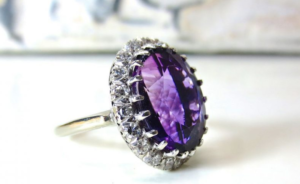Diamond, crystals, zirconia and rhinestones have long been part of the world of accessories and, among us, recognizing precious stones is not one of the simplest activities. So, if you are a reseller , having this knowledge can be a differential in your favor.
To help in this task, we will talk about the peculiarities of each one, the differences between these four types of stones and in which styles of jewelry, semi -jewelry and jewelry are used most often, in addition to three factors to consider when buying. Check out!
Diamond
Considered the most resistant and expensive gemstone in the world, diamond is a gem of mineral origin that is formed from carbon in millions of years. And all this under the ground at high pressure and temperature.
It is so hard that no other mineral can hurt it, except another diamond stone. It can be polished in several ways, the brilliant shape being the most well-known, to the point of being confused with the stone’s own nomenclature.
The diamond cannot be wetted by water, at the risk of losing its luster and, with the other types of gem, it is used for the manufacture of jewelry , exclusively. This is due to the fact that it is the most valuable stone in the world, making its application in semijias and costume jewelry unfeasible and disadvantageous.
Crystals
When talking about crystal, there is a wide range of concepts and it is necessary to recognize them to understand. Crystals are formed from nucleation, that is, when one substance dissolves in another. By joining the structures of each molecule, of different materials, they dissolve into each other and form a larger structure, which will also dissolve over time.
As this phenomenon does not happen naturally on the planet, the Czech Daniel Swarovski invented a machine that revolutionized the process of cutting crystal, causing the stones to be made with extraordinary precision.
Thus, Swarowski crystals became known worldwide as an imitation diamond that comes very close to the brilliance and beauty of the precious stone.
In this synthesis – the name given to the practice used to create crystals for jewelry and semi-jewels – the stone is formed from glass, crystal and acrylic, gaining all the brilliance similar to that of diamond, as we said.
Crystals, unlike diamonds, can come in different shapes and sizes, as well as different colors. Another difference between the two stones is that diamonds have a hardness of 10 on the Mohs scale, while crystals have a lower number – somewhere around 6 or 7. Even so, like diamonds, crystals can scratch glass.
Zirconia
There are two types of zirconia: baddeleyite – a rare mineral found in nature and that is usually used in the manufacture of jewelry only – and cubic zirconia.
The latter is synthesized in the laboratory with the intention of imitating the diamond. It does not lose its shine in contact with water and is very resistant. Thus, it can be studded with jewelry and semi-jewels.
It is a stone of excellent quality and very shiny and can be considered the best imitation of diamonds ever produced. Lay people and some professionals in the field, even, cannot differentiate the two stones.
However, there are some characteristics that we can try to notice at the time of purchase: if, when looking very close to the stone, inside, you miss any imperfection or black dots, it means that it is a zirconia. This is because the stone is made artificially.
Another factor that differentiates the two is when the light enters the product: zirconias will present the colors of the rainbow much brighter than a diamond. Finally, zirconia is heavier than diamond, so if you have a sample of the two stones of the same size, the second will be the lightest. The difference between one and the other is around double.
Rhinestones
It has this name because the first to produce this stone was the Frenchman George Friedrich Strass, with the intention of creating something with a diamond-like brilliance. It is still a crystal, because it is made from pieces of glass or plastics dissolved in powder or metal film.
It is a synthetic stone and the cheapest among all that we are addressing in this post. In order to shine like a diamond, its base is lined with metal.
Compared to zirconia and diamond, the quality is much lower, justifying the much lower price. It is widely used in jewelry, clothes and shoes, but it is never studded because of its fragility. This process would cause the rhinestones to break easily. Therefore, the adornment is always glued with a special glue.
Main differences between diamond, crystals, zirconia and rhinestones
The main differences begin with the formation of each stone or crystal, whether synthetic or natural. Resistance and rarity value stones, especially natural ones.
Formation
The diamond is natural, forming in millions of years, and is more resistant, in addition to being a very shiny and studded stone in the pieces. The high value does not allow the use in semijias and costume jewelry, only in jewels.
Brightness
The synthesized ones have greater brightness, precision and delicacy, since they are used in high-quality plated jewelry. They can be used in semi-jewels, but the value of these pieces will increase substantially.
Zirconia can be confused with diamond, so much so that it sometimes replaces it. White and very shiny, the synthesized stone is studded with the pieces and darkens with the accumulation of residues. However, with the right product it is possible to restore the natural shine.
Value
Because rhinestones are a synthesized crystal, it may be the one with the least resistance and added value, but it is nonetheless a sophisticated and well accepted adornment among fashion lovers .
What to consider when buying
There are some factors that can influence your customer at the time of purchase. Therefore, presenting options and a certain mastery of the subject will greatly help your choice. Are they:
Price
As previously stated, of all stones, diamond is the most expensive in the world. If it is not your client’s reality, present the advantages when purchasing a cheaper part.
If she needs something durable, resistant and as close to the jewelry as possible, indicate pieces made with zirconia or crystal. If she has in mind something that can be changed frequently, not bothering to buy several pieces in a short period of time, rhinestone ones are best recommended.
Durability
Regarding durability, the price already gives a good tip on how to choose the product. If the client does not mind making a real investment in jewelry, keeping in mind that they can be for a lifetime, present the diamond – which will certainly last – zirconia and crystal, in that order.
If the choice is semi-jewels , products made in cubic zirconia and crystal are durable choices. Of all, those made of rhinestones will have less durability. However, it must be remembered that durability is also related to the bathing process that the semi-jelly received.
Occasion
Knowing when to wear jewelry or semi-jewels can be decisive in the entire look of the client. So, when someone asks for something for an event that involves elegant attire , recommend the stones with more shine, such as zirconia.
If someone is buying an engagement or graduation ring, recommend pieces with quality stones very close to those of the diamond – in case you can’t invest in such an expensive jewel – like cubic zirconia.
If it is the case to use something to go to work, on a daily basis, or to an informal barbecue, without any dress code, recommend the semi-precious stones.
With this information, it is possible to understand a little more the world of precious stones and where the different types of diamonds are most used.
Now that you know more about diamond, crystals, zirconia and rhinestones, leave a comment telling us what your favorite type is and the reason for it! We will love to chat with you!








